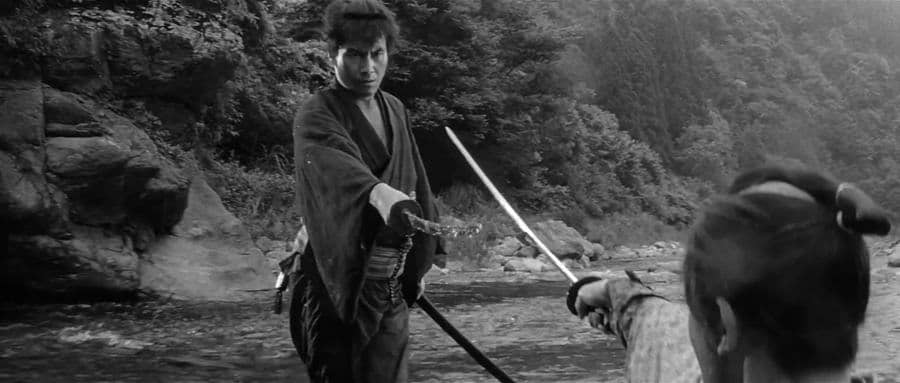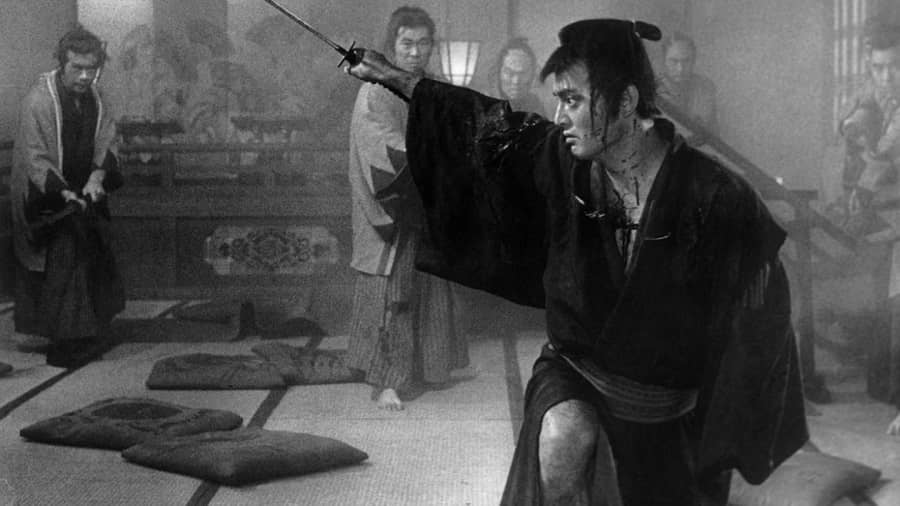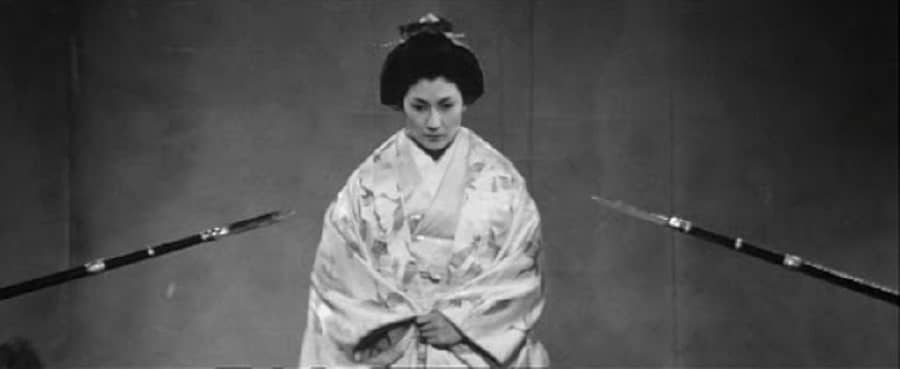Ellsworth’s Cinema of Swords: Rejecting Bushido, Part 2
Sword of the Beast (Japan, 1965)
As outlined in Part One, in the Fifties postwar Japan’s film industry gradually returned to making chambara movies that glorified the samurai warrior code of bushido, but in the counter-cultural Sixties some filmmakers took an opposite tack, blaming bushido for supporting a culture of rigid oppression and cruelty. Some remarkable films came out of this movement, pictures of high art that depict the samurai’s wonderfully skilled swordplay while skewering the society that relied on the sword as a tool of domination. Let’s look at three films that exemplify this movement from three brilliant directors: Hideo Gosha, Kihachi Okamoto, and Masaki Kobayashi.
Sword of the Beast (or Samurai Gold Seekers)
Rating: ****
Origin: Japan, 1965
Director: Hideo Gosha
Source: Criterion DVD
Co-writer and director Hideo Gosha’s follow-up to Three Outlaw Samurai takes an even less forgiving view of society than its predecessor: individuals may be good, bad, or both, but hierarchical authority cares only for power and does only ill.
It’s 1857, the Shogunate is in tatters, and samurai Gennosuke (Mikijiro Hira) is on the run, pursued by members of his own clan because he slew a counselor who rejected reform. While hiding in a shabby gambling hall, he learns of a government preserve, a mountain where outlaws are illegally prospecting for gold, and decides to seek escape, and perhaps his fortune, up the valley of gold. We learn in flashback that the naïve Gennosuke had been suckered into killing the counselor by a lower officer who then betrayed him, so now he’s turned his back on society. Meanwhile, a band of crooked thugs are also planning to loot the mountain, but they’re stopped by another samurai, Jurota (Go Kato) and his wife, Taka (Shima Iwashita) who are there ahead of them. Jurota has been secretly gathering gold on the orders of his own unnamed clan and will stop at nothing to succeed in his mission, even when Taka is abducted by the thugs. Gennosuke comes up the valley, and though he wants Jurota’s gold, he saves Taka from the thugs and comes to an uneasy détente with the clan swordsman. But then Gennosuke’s pursuers arrive, followed by Jurota’s clan assassins, who’ve been ordered to get Jurota’s gold and kill everyone on the mountain.
This grim tale is deliberately shot in beautiful mountain wilderness to contrast the humans’ bestial behavior with the serenity of nature. Combat is authentically brutal, a stain on the natural world. Gennosuke refuses to face his pursuers directly, forswearing samurai honor and vowing to become an animal who lives like a wolf, but when confronted with threats from genuine animals like the gang of thugs, he can’t sink to their level. When he learns that Jurota and Taka have been targeted for death by their own clan, though they’ve done nothing but risk their own lives to follow orders, Gennosuke chooses to fight on their behalf, even as his own clan’s pursuers catch up to him. In the end, Gosha says, an individual can depend only on their own integrity, because to maintain power their clan will always betray them.
The Sword of Doom
Rating: *****
Origin: Japan, 1966
Director: Kihachi Okamoto
Source: Criterion DVD
This extraordinary film tells the story of a samurai who trusts only his sword, has no principles but its use, and his sword’s only purpose is killing. If this sounds like the most antiheroic, nihilistic Sixties thing ever, you’re not wrong, but Doom isn’t just another film about the hollowness of the bushido warrior code that led the previous generation to disaster in World War II. This story is older, based on a popular Japanese serial novel by the pacifist Kaizan Nakazato that began publication in 1913 and had been filmed at least four times before. But Okamoto’s version, distilling the events of that very long novel into under two hours, is a punch in the gut you won’t soon forget.
Ryunosuke, the protagonist — we can’t call him the hero — is played by the great Tatsuya Nakadai, and he gives the swordsman the empty eyes and vacant expression of a soulless sociopath. We first see him appear behind an old man at a mountain shrine praying to die well — so Ryunosuke kills him, leaving the body to be found by his granddaughter Omatsu (Yoko Naito). Ryunosuke returns home to prepare for a demonstration duel with Bunnojo (Ichiro Nakaya), a match Bunnojo must win to earn a position and provide for his family. Ryunosuke’s aging father urges his son to let Bunnojo win, as does Bunnojo’s wife, Ohama (Michiyo Aratama), who comes in private to plead with him. Ryunosuke promises Ohama he’ll lose, but then rapes her (offscreen — it’s the one mercy this film affords us) and sends her home to Bunnojo. He divorces her and goes to the match with rage in his heart, enabling Ryunosuke to lure Bunnojo into a deadly attack that gives him a pretext to kill him. Ryunosuke escapes prosecution but is now a pariah, and what’s left of his humanity begins to crumble away.
There isn’t much fun to be had in this film — indeed, it denies the very possibility of the existence of fun — but there is beauty. Director Kihachi Okamoto’s every shot is meticulously composed, the pacing is masterful, and the performances are restrained and all the more striking for that. The one-on-one duels are suspenseful, as Ryunosuke seems almost to slowly collapse before his opponents, drawing them in to an attack that will be their last. The mass combats are both savage and balletic, the moves elegant but the resulting injuries cruel. Okamoto’s eye is precise and spares us nothing.
Having lost everything, Bunnojo’s widow Ohama follows Ryunosuke and becomes his common-law wife as he seeks a living as a sword-for-hire. The story is set in the 1860s, during the dying days of the Shogunate, and Ryunosuke joins the Shincho group, a death squad of samurai who murder the Shogun’s political enemies. But the killer is also being stalked by Bunnojo’s younger brother Hyoma (Yuzo Kayama), who studies swordplay at the school of Master Shimada (Toshiro Mifune — yes!). Ryunosuke learns from Omatsu, whose grandfather he’d murdered in the first scene, that Hyoma is after him, but he has no fear because he’s never lost a fight and considers himself invincible. He believes that he and his sword are supreme, until the night the Shincho group attacks Shimada, mistaking him for someone else, and Ryunosuke watches in frozen amazement as Shimada cuts down every single Shincho but him. Faced with visible proof that he is neither supreme nor invincible, that his every achievement is hollow, Ryunosuke begins to unravel. Haunted by visions of those he’s slain, including his own wife Ohama, he descends into a final mad frenzy of blood lust. What, you expected a happy ending?
Samurai Rebellion
Rating: *****
Origin: Japan, 1967
Director: Masaki Kobayashi
Source: Criterion DVD
Sometimes, all you can do is refuse.
This is director Kobayashi’s follow-up to his Harakiri (1962), and it bears some similarities to that film: it’s a story about resistance to the cruelty of the rigid samurai social system, it spends most of its length carefully and artistically setting up the explosion of violence at its climax, and it features the always-excellent Tatsuya Nakadai in a key role. But Samurai Rebellion is more densely layered than Harakiri, with a larger cast to depict its complex conflicts of duty and morality, and most importantly its pivotal character is not a samurai warrior, but a samurai wife.
In 1725, Isaburo (Toshiro Mifune) is a mid-level functionary in the Matsudaira clan whose only real skill is swordplay, which during the peaceful Tokugawa Shogunate nobody has a need for. His clan’s daimyo, or warlord, decides to dump his young mistress Lady Ichi (Yoko Tsukasa) in favor of another, but because Ichi has borne the lord a son, she must be honorably placed somewhere in the clan. The daimyo chooses to marry her to Isaburo’s son Yogoro (Go Kato), but Isaburo’s family is reluctant to accept, as Ichi is said to have lost her temper and actually slapped the daimyo. However, eventually they agree, and surprisingly the marriage between Ichi and Yogoro is a happy one, blessed by a daughter, Tomi. Then the daimyo’s eldest son unexpectedly dies, his child by Ichi is declared the new heir, and she is summoned back to the castle to care for him. But first she must divorce Yogoro and leave behind their infant daughter.
Isaburo and his family feel trapped by law and duty into giving Ichi up, but she turns out to be stronger than they and refuses to give in. Isaburo and Yogoro join Ichi in defying the daimyo’s authority, the clan starts tightening the screws, and events begin to bend toward the inevitable break. Differing opinions within the clan are represented by Isaburo’s friend Tatewaki (Nakadai), who deplores the daimyo’s arbitrary cruelty but sees no option but obedience, and Takahashi the cruel clan steward (Shigeru Koyama), who relishes the opportunity to break Isaburo’s family to the daimyo’s will. Koyama is great in this villainous role, so coldly repellent that from the first moment he appears you can scarcely wait until meets his well-deserved end.
Unlike the lush visuals of Kobayashi’s art-horror film Kwaidan (1964), here he returns to the austerely striking compositions of Harakiri, providing simple, clear backdrops for his characters’ complex emotions. The climactic combats, two mêlées and a duel, are passionate and affecting, even poignant. As in Yojimbo and Sanjuro, Mifune and Nakadai face off at the end, but the harsh strictures of bushido mean that this time there can be no winners.
Where can I watch these movies? I’m glad you asked! Many movies and TV shows are available on disk in DVD or Blu-ray formats, but nowadays we live in a new world of streaming services, more every month it seems. However, it can be hard to find what content will stream in your location, since the market is evolving and global services are a patchwork quilt of rights and availability. I recommend JustWatch.com, a search engine that scans streaming services to find the title of your choice. Give it a try. And if you have a better alternative, let us know.
The previous installments in the Cinema of Swords include:
The 7th Voyage and Its Children
The Good, the Bad, and Mifune
The First British Invasion
Wholesome Buccaneers (Pt. 1)
The Tale of Zatoichi
The Sign of the Z!
Gallic Gallantry
Classic, Mythic and Epic
The Exuberant Excess of Sixties Vikings
Tyrone’s Typecast Troubles
Not-So-Wholesome Buccaneers
Daimajin Strikes Again!
Three Counts of Monte Cristo
Mongols, Cossacks, And Tartars
I Heard You Like Swords
Bard’s Tales
Hu’s on First
Flynn’s Last Flourishes
Mighty Colossi And Hydrae
Rejecting Bushido (Part One)
Pirates — Italian Style
The Year of Camelot and Scarecrows
LAWRENCE ELLSWORTH is deep in his current mega-project, editing and translating new, contemporary English editions of all the works in Alexandre Dumas’s Musketeers Cycle, with the fifth volume, Between Two Kings, coming in July from Pegasus Books in the US and UK. His website is Swashbucklingadventure.net.
Ellsworth’s secret identity is game designer LAWRENCE SCHICK, who’s been designing role-playing games since the 1970s. He now lives in Dublin, Ireland, where he’s writing Dungeons & Dragons scenarios for Larian Studios’ Baldur’s Gate 3.



I caught The Sword of Doom for the first time last year and found it riveting. I do think there is fun in this film…of the sort to be had in, say, MacBeth.
Aw yeah. Thanks for this.
I haven’t seen Sword of the Beast since I got the Rebel Samurai set years ago. Your review offered proof positive that I am long past due to watch it again.
But Sword of Doom…
The story, the flow of the plot, can feel strange, truncated, dislocating to a casual viewer but the power of the performances, the eerie beauty of the cinematography and the literally stunning scenes of swordplay make this a must-see classic for anyonoe who loves film.
I feel a temptation to wax hyperbolic here, and I shouldn’t. Suffice to say that, the first time I watched the film, the climactic battle –Ryunosuke against the world– was so overwhelming that when it was over I found I had somehow moved from my comfortable position on the couch and was kneeling in front of the television with my hands clenched into fists. This film is unique and unforgettable.
The mistaken ambush episode in Sword of Doom is one of my favorite movie scenes of all time.
Another Ellsworth’s Cinema of Swords? Wunderbar!
While I have seen and enjoyed Sword of the Beast and Samurai Rebellion multiple times, it is The Sword of Doom that dominates any discussion that includes it. It is a work of genius (I second Mr. Dooley’s take on the mistaken ambush) but it is one of the few films that I cannot bear to watch again. Its echoing bleakness left enough of a mark the first time.
Thank you, Mr. Ellsworth!
Another great write up of Samurai films! Sword of Doom is good, but to me is lacking in that final stopping in the middle of the story, due to poor box office stopping the planned sequel. About like Star Wars ending at Empire. Have you seen the previous cinematic versions of the Sword of Doom source novel, where they film the entire book, specifically Souls in the Moonlight, and Satan’s Sword? Each version is a trilogy, and follows the book in slightly different ways. In both, Ryunosuke becomes blind during the big fight that ends Sword of Doom, and wanders off as a blind swordsman (shades of Zatoichi) pursued by Hyoma and others seeking vengeance. The Satan’s Sword trilogy stars Ichikawa Raizo as Ryunosuke, presaging his fantastic turn as Kyoshiro Nemuri, another amoral samurai at the start of that series.
Thanks, I haven’t seen either of those versions! I’ll have to keep a lookout for them.
You’re welcome. The Satan’s Sword trilogy is more widely known under the novel’s title, Daibosetsu Toge. It tends to follow the later Sword of Doom version more, whereas Souls in the Moonlight goes all over the place introducing characters and subplots. I don’t think the novel has ever been translated into English, so I have no idea which one follows the book more closely. But for my money, the second version with Ichikawa Raizo is much more appealing, whereas the first version with Kataoka Chiezo is more like a Toei all-star cast singing and dancing extravaganza.
I don’t know what it is about Japanese samurai films, but I have never seen a bad one. I mean, EVER.
I know what you mean. My assumption is that Sturgeon’s Law still applies, and the crappy chambara flicks just don’t get English language versions.
It depends on where you look. I’ve seen a few that are terrible–bad plot, bad action, bad production values. But, most films are indeed watchable.